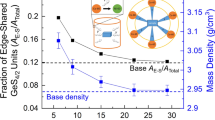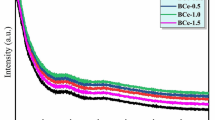Abstract
The optical absorption (in the 400–1000 nm region) and electron paramagnetic resonance (EPR) spectra of 50PbO-20Cr2O3-(30-y)B2O3-yAl2O3 glasses and those crystallized by suitable thermal treatments have been studied. The results are applied to account for the crystallization process, which revealed the crystalline products due to PbCrO4 and Pb2CrO5, and crystallization yield was found to be drastically enhanced (by as much as ∼ 85 vol%) with Al2O3 additives. The addition of Al2O3 in the present glasses and/or the thermal treatments induce the optical absorption intensity in the visible region at the expense of the near infrared region and reflect a gradual decrease in the EPR linewidth, ΔH, at g∼2. The chromium in these cases most likely exists in a thermodynamic equilibrium between Cr3+ and Cr6+ oxidation states and the Al2O3 favours the Cr3+⇌Cr6+ nucleation transformation to accord with the above observations. In addition, the crystalline PbCrO4 and Pb2CrO5 comprise CrO 2−4 groups with the Cr6+ oxidation state of chromium. This presents a phenomenological correlation for a local symmetry similarity of the CrO 2−4 groups in glass and the microcrystalline products and observation of an enhanced crystallization yield due to Pb2CrO5 crystallites in the glasses using Al2O3 additives. The chromium occupying the tetragonal CrO 2−4 anion sites migrates rather easily from the glass (subject to the thermal treatment) to the growing nucleation sites of PbCrO4/Pb2CrO5, whereas those Cr3+ usually occupying the octahedral sites, which are associated with characteristically large stabilization energy, hardly play a direct role in the crystallization.
Similar content being viewed by others
References
L. E. Brus, IEEE J. Quant. Electron. 22 (1986) 1909.
P. Roussignol, D. Ricord, C. Flytzanis and N. Neuroth, Phys. Rev. Lett. 62 (1989) 312.
S. Ram and K. A. Narayan, Ind. Engng Chem. Res. 26 (1987) 1051.
K. Toda and S. Morita, Appl. Phys. A 33 (1984) 231.
S. Morita and K. Toda, J. Appl. Phys. 55 (1984) 2733.
K. Toda and S. Morita, ibid. 57 (1985) 5325.
S. Ram and K. Ram, J. Mater. Sci. 23 (1988) 4541.
M. Irion, M. Cauzi, A. Levasseur, J. M. Reau and J. C. Brethous, J. Solid State Chem. 31 (1980) 285.
Y. Ito, K. Miyauchi and T. Oi, J. Non-Cryst. Solids 57 (1983) 389.
R. J. Landry, J. T. Fournier and C. G. Young, J. Chem. Phys. 46 (1967) 1285.
S. A. Brawer and W. B. White, J. Chem. Phys. 67 (1977) 2043.
A. Lempicki, L. Andrews, S. J. Nettel, B. C. McCollum and E. J. Solomon, Phys. Rev. Lett. 44 (1980) 1234.
L. J. Andrews, A. Lempicki and B. C. McCollum, J. Chem. Phys. 74 (1981) 5526.
F. Durville, B. Champagnon, E. Duval and G. Boulon, J. Phys. Chem. Solids 46 (1985) 701.
S. Sugano, Y. Tanabe and H. Hamimura, “Multiples of Transition Metal Ions in Crystals” (Academic Press, New York, 1970).
D. K. Sardar, M. D. Shinn and W. A. Sibley, Phys. Rev. B 26 (1982) 2382.
A. M. Stoneham, “Theory of Defects in Solids” (Oxford University Press, Oxford, 1975).
M. Wolfsberg and L. Helmholz, J. Chem. Phys. 20 (1952) 837.
B. F. Mentzen, A. Latrach, J. Bouix and A. W. Hewart, Mater. Res. Bull. 19 (1984) 549.
A. Abragam and B. Bleaney, “Electron Paramagnetic Resonance of Transition Ions” (Clarendon Press, Oxford, 1970).
D. L. Griscom, J. Non-Cryst. Solids 13 (1973–74) 251.
J. S. Thorp and W. Hutton, J. Phys. Chem. Solids 42 (1981) 843.
I. Ardelean, G. Ilonga, M. Peteanu, E. Barbos and E. Indrea, J. Mater. Sci. 17 (1982) 1988.
J. C. M. Henning and H. Van Den Boom, Phys. Rev. B 8 (1973) 2255.
A. J. Wojtowicz and A. Lempicki, ibid. 39 (1989) 8695.
J. C. Ruckman, R. T. W. Morrison and R. H. Buck, J. Chem. Soc. Dalton Trans. 1 (1972) 426.
S. Ram, J. Magn. Mater. 82 (1989) 129.
Author information
Authors and Affiliations
Rights and permissions
About this article
Cite this article
Ram, S., Ram, K. & Shukla, B.S. Optical absorption and EPR studies of borate glasses with PbCrO4 and Pb2CrO5 microcrystals. J Mater Sci 27, 511–519 (1992). https://doi.org/10.1007/BF00543945
Received:
Accepted:
Issue Date:
DOI: https://doi.org/10.1007/BF00543945




